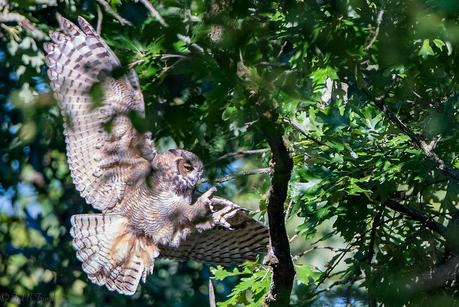
It's both an exhilarating privilege and a bittersweet moment to be able to experience what could be the last of something beautiful. After all, there's no telling if it will last forever. There's no telling if you would be able to re-experience that thing again, or if it will undergo some massive change. That's why we felt quite fortunate and blessed that we were able to visit the lush Nug-as Forest Reserve in Alcoy, Cebu, the last original rainforest in the island. We passed by this forest during our Cebu Highlands Trail Segment 5 hike. Now, we're actually going inside it!
Award-winning travel blogger and friend Edgar Alan Zeta Yap of EAZY Traveler invited us for a birdwatching adventure in the highlands of Nug-as, Alcoy, which we readily agreed. This was also our first time to meet blogger Christine Fernandez of Jovial Wanderer, who is also a cool adventurer like us.
After a hot lunch in a carenderia, we rode habal-habals to the highlands of Alcoy. It is difficult to imagine that the smooth, asphalted road we're traveling on was once a rocky, dusty dirt road which serves as the only link between the municipality's capital and the remote farms and mountain communities.
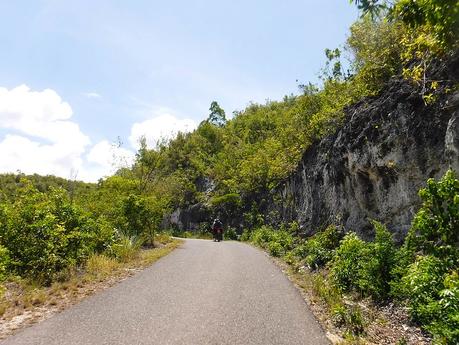
Around 20 minutes later, we arrived at what seems to be a small dilapidated building right at the edge of the Nug-as Forest Reserve. The habal-habal drivers said this is our jump-off point, and our guide will arrive shortly. While waiting, we rearranged our Deuter packs and double-checked everything in the middle of silence. Indeed, the only sound we heard are rustling leaves and distant drones of motorcycles.
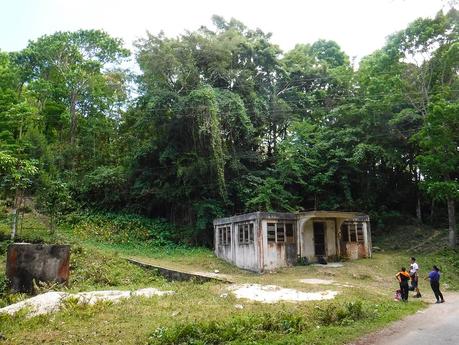
Our guide arrived 10 minutes later. After a short briefing, we strapped on our heavy backpacks, ready for a whole afternoon of trekking. We had packed food, tents, cold weather gear-enough to make our overnight weekend stay comfortable. Full of energy and excitement, we climbed up the stairs that led to the depths of the forest reserve...
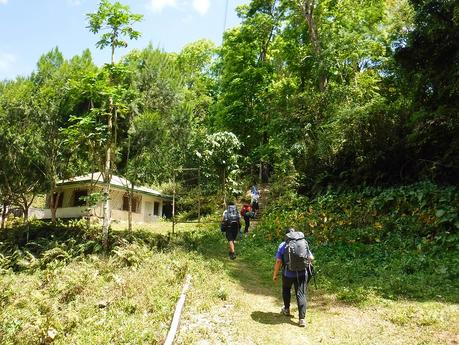
...and we arrived at our campsite in less than 3 minutes. Yes, we carried all those preparations for an overnight stay for a 3-minute climb. Right below us, we could see the road, and vehicles roar by every now and then.
Across the road lies a small dirt path that leads to a small community where there is-to our great delight-a sari-sari store that sells cold softdrinks!
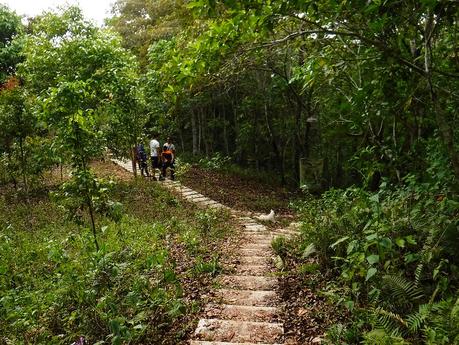
The concrete pathway leads to the Nug-as Forest Reserve research center, a concrete sturdy structure that is actually self-sufficient. It has basic amenities including electricity and running water. No air-conditioning though, but that's fine. The forest air makes everything comfortably cool here.

The two-story research center is built for researchers who want to study the reserve for the long term. It has a study area, a lounge, a kitchen, and toilet and bath. The second floor houses two bedrooms where researchers can spend their nights.
Food? No problem. Households from nearby communities can prepare hot home-cooked food from fresh ingredients straight from the farm. Just ask the caretaker, and he'll take care of everything.
With permission from the LGU and after paying a reasonable fee, visitors can also stay in the facility. Yes, you don't need to camp here!
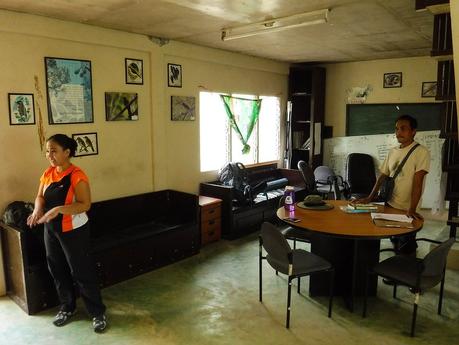
Our guide had to do some errands at home, and he said that the birds don't appear until later in the afternoon anyway. So while waiting for the right time to birdwatch, we set up our tents for the night. But if we've known we can stay in the research center, we didn't have to bring all our camping equipment. Just some extra clothes, inflatable pillows, and blankets will do.
Check out those small trees just right beside the concrete pathway. These are actually young Cebu cinnamon trees, which are endemic in Cebu.
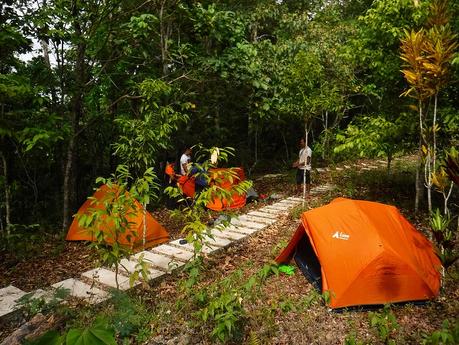
Around 4 PM, our guide went back and announced that we're going to start the tour. At last, we're going deep into the forest to try to spot some rare birds. But he said we don't need anything other than our water bottles! Huh? Well, it turned out that we could actually watch birds by just walking down the road! Yes, that's the road that led us here!
As we started walking back the way we came, we heard the increasing cacophony of sweet bird calls as the avians started hunting for food or calling for mates.
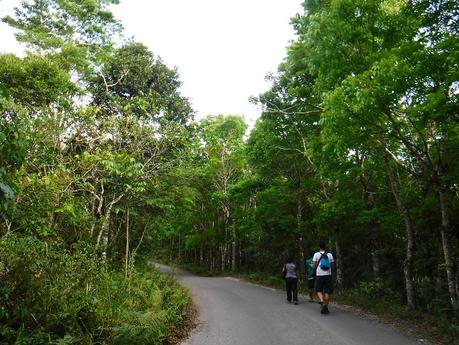
Like many locals, our guide once hunted birds in this area. But all that changed when foreign birdwatchers, ornithologists, and researchers came to visit and document the flora and fauna in Nug-as. What he learned during their visit changed his outlook on Mother Nature forever. He realized how important it is to protect the ecosystem and maintain this natural treasure.
Today, he is one of the many guardians of the Nug-as Forest Reserve, protecting its inhabitants from hunters, poachers, and careless locals. Under the Cebu Biodiversity Conservation Program, he and a team of local volunteers also patrol the forest, making sure it remains pristine and a safe haven for all its denizens.
The most amazing thing about him? He is able to imitate bird calls! We kid you not!
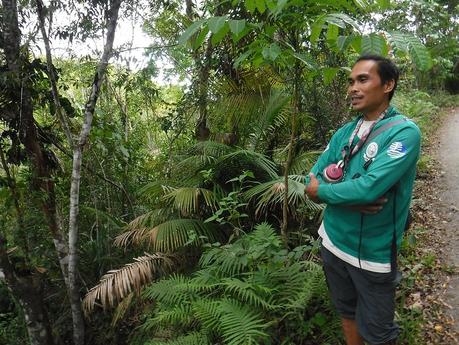
Gmelina trees can be seen on either side of the road. It is not an endemic plant, and it has adapted as a parasitic tree. How? Well, Gmelina trees require a lot of water to survive. Whenever there's water, the roots suck up moisture rapidly, depriving local foliage of the life-nourishing liquid.
Nevertheless, Gmelinas are quite strong. Seasoned correctly, it is quite resistant to decay and termite infestations. Its timber can be used as raw material for musical instruments, furniture, carriages, and more.
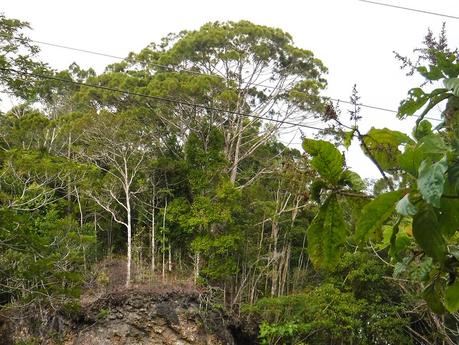
The Cebu mistletoe looks pretty, but it's actually a parasitic plant endemic to the Cebu island. It grows on other trees, sucking on their nutrients. Imagine having an extra alien limb growing on your body feeding on you! That is what it does, and thinking about it is horrifying!
Yet parasitism is important for natural balance. The parasitic relationship weeds out the weak, so only the strong survives.Without parasitism, the ecosystem will be filled with sick, unhealthy, and disease-ridden flora and fauna.
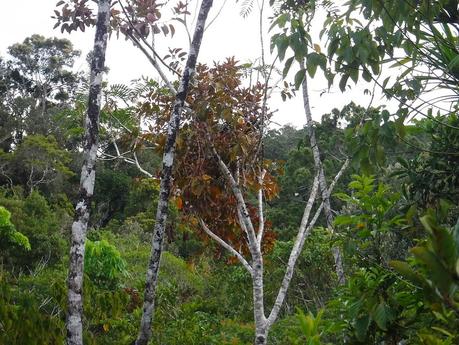
Of course, we came here for birds, and birds we saw. The most common ones were Cebu streak-breasted bulbuls, a type of songbird endemic to the Philippines. While they prey on worms and bugs, they are also prey for larger kites and hawks that soar around this area. Unfortunately, even though they are a common sight here, Cebu bulbuls are actually threatened by habitat loss as more forests disappear each year.
Important Note: Using binoculars, we were able to see these birds quite clearly. Unfortunately, without the right photographic equipment, skills, and tools, it is impossible to take close-up shots of the birds. So we just took photos from Creative Commons so you, dear reader, can clearly see how the birds look like.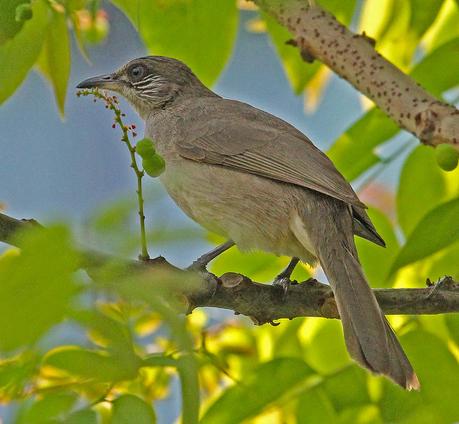
As the sun set, we came upon an peculiar clearing surrounded by trees. Our guide asked us to be completely silent as he turned on a battery-powered speaker, playing a recording of soft bird calls. A few minutes later, a bird came flying out of the forest and perched on a branch above us.
We had our first glimpse of the rare earless Cebu Hawk Owl. They mate early in the year and make their nests in tree hollows.
The guide explained that the Cebu Hawk Owl is extremely territorial. Apparently, when the owl heard the recorded bird call, he thought that another bird is in his territory. As such, he flew over to investigate, irritated that someone has "trespassed" in his territory. We could see the owl's eyes scanning the area furiously, frustrated that no other bird was in sight. Yeah, he was stressed!
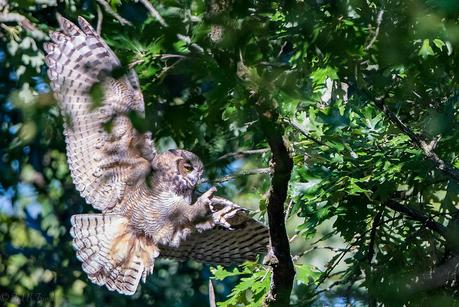
As the sun set below the mountains, we returned to our camp, put on our sweaters, and cooked a delicious and hot dinner. And we did mention there was a store nearby, right? So.....soda and chips!
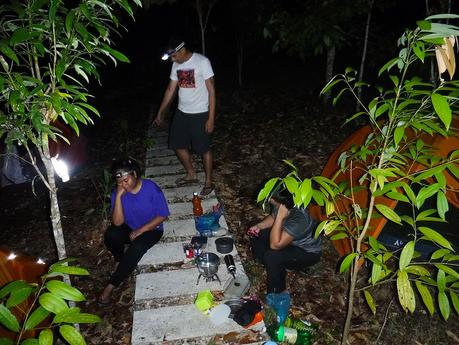
The next morning after we had breakfast, our guide returned for some more bird watching. This time, however, we want to go inside the Nug-as Forest Reserve itself. Packing lightly, we followed his lead among a reforested part of the trail.
These trees are mahoganies, planted during an earlier reforestation effort. While mahoganies grow quickly, they are actually parasitic like gmelinas. It sucks up a lot of water, the wood is too hard for birds to peck through, and the fruit is inedible. But it does provide a lot of shade.
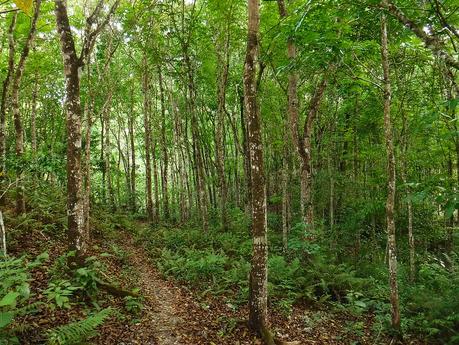
Before entering the Nug-as forest, we passed by some local farms. Farming and hunting are still main sources of livelihood in these highland areas.

As we started a gentle ascent towards the forest, we could see the karst hills of southern Cebu in the distance. Seeing the magnitude of Cebu from this viewpoint made us realize just how beautiful and rich our island is. And there is still so much to discover. Cebu is indeed a place worth of our love, admiration, and protection.
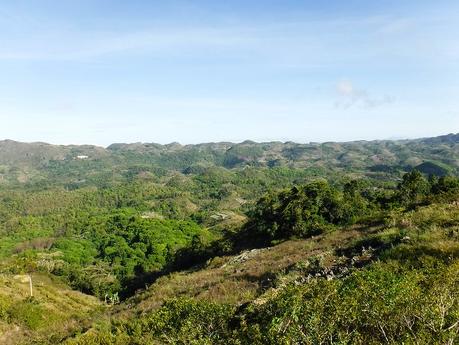
As we neared the forest's edge, we walked on what seems to be razed land. As demand for agricultural produce increases, locals raze large tracts of woodlands to make way for farms. We understand the need for livelihood, but we were quite concerned that the razing has now reached the forest's edge. Hopefully, this won't go farther.

We entered the Nug-as Forest via an old hunter's trail. Although the trail leads deep into the reserve, we opted to just stay at the outskirts; exploring the depths of the Nug-as Forest will take us a day or two.
We stopped at various points which are rich in bird sightings. We kept absolutely still while the guide played his bird-call recordings. By being still and quiet, birds are more "comfortable" to approach us.
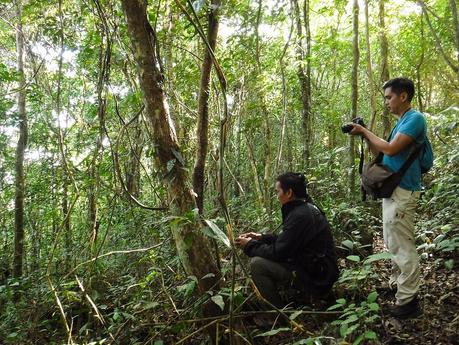
After about half an hour, our patience-and silence-paid off. We saw sightings of Black Shama, locally known as siloy. Black Shamas are endemic to Cebu, which means that the bird is restricted or peculiar only to the island. Due to habitat loss and its being endemic to Cebu, it is one of the most endangered birds in the world.
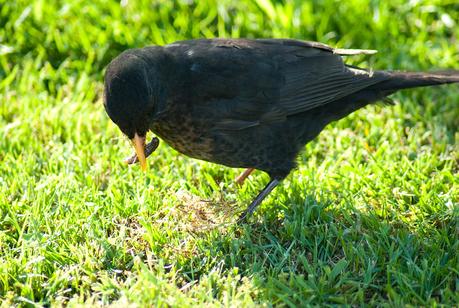
We also saw colorful emerald doves roosting on top of light woods along the forest. Emerald doves are distributed widely in tropical and sub-tropical countries. Although expert weavers, they make rudimentary nests made of simple twigs and sticks. These doves are quite used to human civilization; in fact, we saw some resting on the roofs and clotheslines of houses we passed when we went back to our campsite.
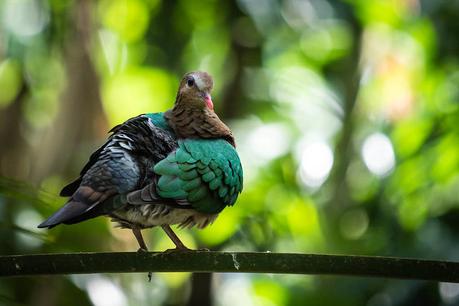
High above the trees, birds make their homes. But why do birds put their nest high above the trees? Is it for the view? For ease of access? Nope! The placement is actually for protection; it is very difficult for ground-based animals to climb towering trees to prey on the eggs or chicks.
Our guide said that in the next mating season, the mama bird would probably look for another tree to build her nest on. She doesn't want to leave a predictable pattern for predators! Clever!

Nug-as Forest does not just play host to birds. It also harbors a rich variety of flora. Just check out this Venus slipper orchid. While it is beautiful, it is actually dangerous to insects; its "cup" is filled with a slippery lining that causes insects to fall in it.
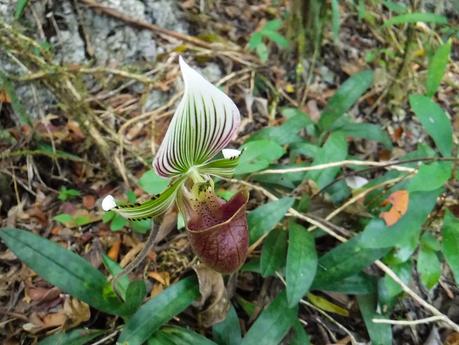
Pitcher plants are also common in Nug-as Forest. Pitcher plants usually grow in places where there's a lack of nutrients in the soil. To supplement their "diet," they trap insects and reptiles in their cup. How does it do this? Well, the smell and looks of a pitcher plant attracts small pray to the edge of their cup, which is coated with a slippery mucus. At the bottom of the cup is a pool of digestive juices. A prey that falls into the cup is slowly digested by the plant. Yuck!
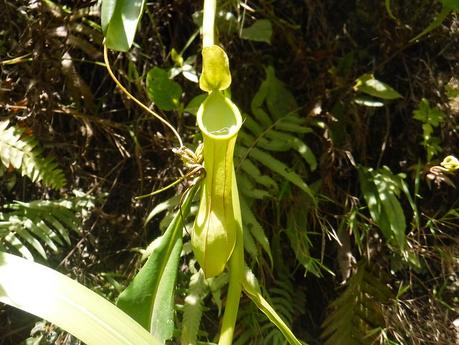
We also found rare orchids in the forest. Locals used to hunt and harvest these lovely orchids to be sold in town. Thankfully, that has stopped after Nug-as Forest was given legal protection.
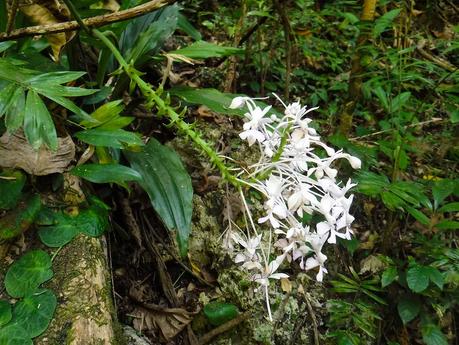
Various molds also grow everywhere in the forest. Be careful though; many of them are poisonous!
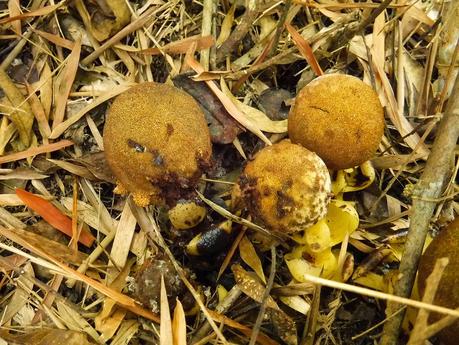
An albino tree? What's weird about it is that the trunk is pure white rather than the usual green or brown. Nature is full of mysteries.
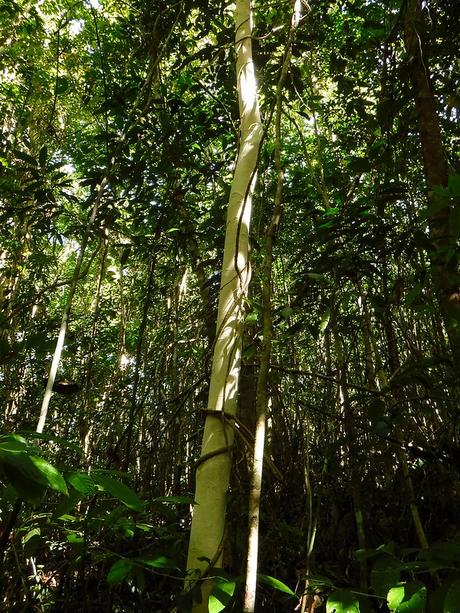
Going deeper into the Nug-as Forest is a hazardous undertaking. The forest grows on top of a limestone karst mountain range. As such, there are lots of deep sinkholes and unexplored caves in the area. Many of these deep, dark holes are covered with vegetation or bridged with rotten limestone rock.
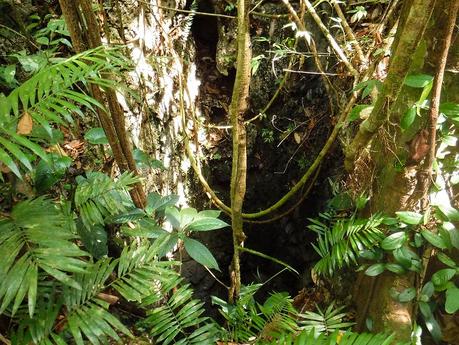
After a very productive morning, we hiked back to camp and packed up. Our contracted habal-habals were waiting for us, ready to take to the lowlands. To cap a successful birdwatching adventure, we decided to have a delicious lunch in a local resort in Alcoy.

The Nug-as Forest Reserve is more than a Cebuano natural treasure. It is an important home and hunting ground for our feathered friends, many of which are critically endangered or can only be found in Cebu. This makes them and the forest they live in truly special. As such, it is a natural treasure worthy of our wholehearted stewardship.
Tips to follow
